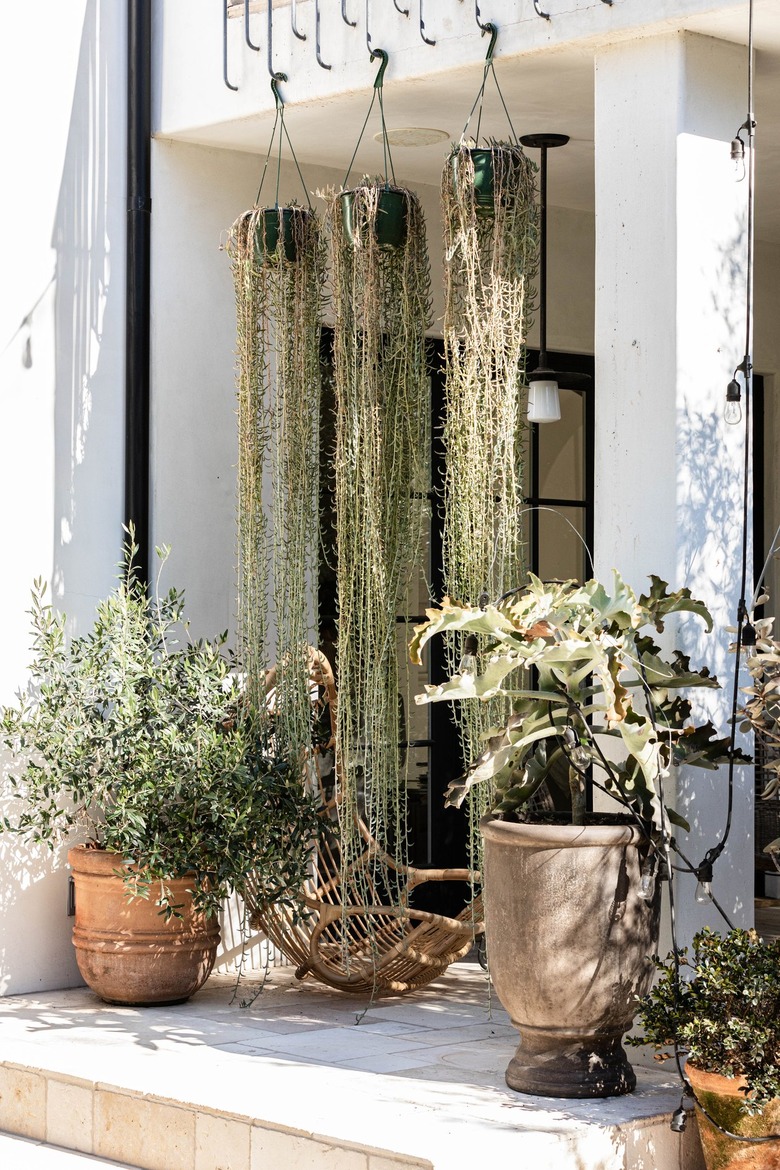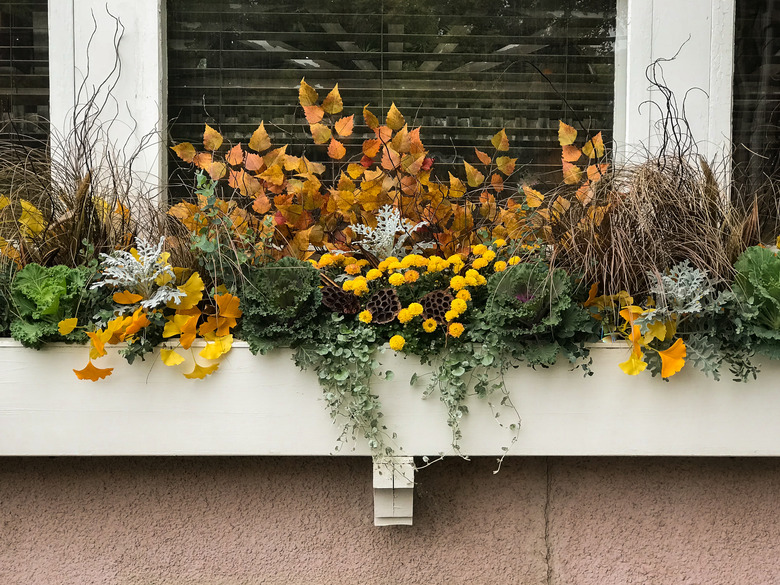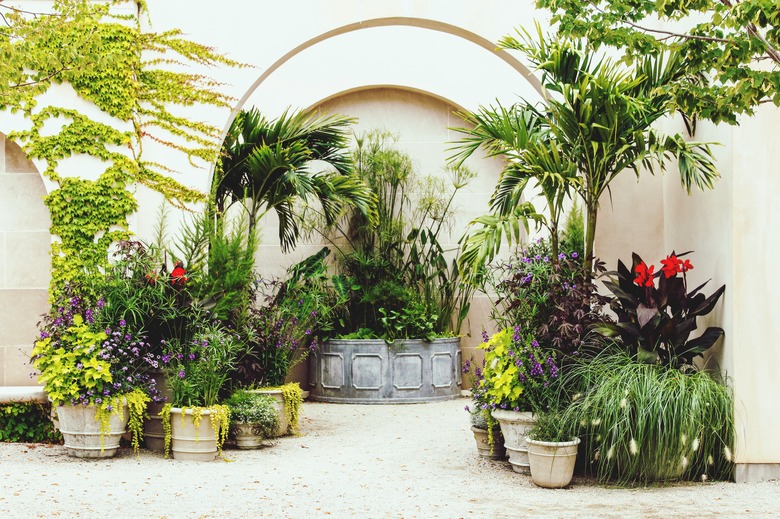A Beginner's Guide To Container Gardening
We may receive a commission on purchases made from links.
Container gardening is an easy way to get started in the plant-growing world. Containers offer a manageable, easily digestible way to start your gardening journey. Container growing is ideal for people living in homes with limited or small outdoor spaces. It's also perfect for those with nonpermanent living situations because if you have to move, it's easy to bring your plants with you. Additionally, growing in pots is a great way to introduce kids to gardening.
Container Gardening Basics
Container Gardening Basics
Growing in containers involves planting flowers, herbs and vegetables in pots instead of directly in the ground. Container gardens can be compact — in small flowerpots — or very large — in large pots or even half barrels. It all depends on the size and number of containers you're using. Raised beds are also sometimes referred to as container gardens. More often than not, though, containers refer to potted plants that you can move around. If you're not digging in the ground and you're adding your own garden soil to it, it's probably a container.
There are several advantages of container gardening:
- It's easy to keep tabs on plants: Most people have container gardens on their patio, deck or balcony. Having the pots nearby means you can check on their progress and health more frequently than you might with an in-ground garden.
- Portability: Not only can you bring plants with you if you move but you can also move them around at any time. If you're trying to grow tomatoes (Lycopersicon esculentum, USDA zones 10-11) but don't have the perfect spot for full sun (which tomatoes need), growing in containers allows you to move around your plant throughout the day to maximize sun exposure. You can't do that with an in-ground plant. You can also bring plants indoors so they can survive the winter. Some containers, like window boxes, can't be moved indoors, unless the window box is a separate planter that fits into brackets installed underneath a window.
- Attractive display: In-ground and other types of large, permanent garden beds can look beautiful, but you can be extra creative when growing in containers. Opt for different shapes, colors and textures to create a marvelous display for your deck or balcony.
- Accessibility: Because they're movable, you can place containers so that they're accessible to people in either standing or seated positions. For instance, gardening with containers might be easier if you have chronic back pain and need to avoid bending.
- More manageable: Growing in pots is a lot easier for new gardeners because it's more digestible. Keeping tabs on an entire yard filled with plants can be overwhelming. A few pots? No big deal! It's also easy to scale up when you've acquired more confidence in your gardening skills.
Though container gardening is great, it also has some downsides:
- Frequent watering is required: Pots tend to dry out quicker than in-ground beds. Since you can't set up an irrigation system for most containers, you'll spend more time watering than you would with a permanent garden bed. There are ways to get around this, though. Water bulbs and self-watering pots are an option if you're tired of catering to your thirsty plants or if you're going on vacation.
- You'll need to fertilize regularly: Your container-bound plants will use up nutrients quicker than those in in-ground beds. Their roots can only travel so far, after all.
- You might have to repot: With edibles, repotting isn't a concern. At the end of the season, you pick ripe tomatoes or snip off fresh annual lettuce (Lactuca sativa) leaves, and the plant eventually gets tossed into the compost. Perennials and dwarf fruit trees are another matter. Some will eventually outgrow their containers. Repotting can prevent them from becoming root-bound.
- Some plants don't grow well in containers: It's true that you can grow almost anything in a container. Even some of the most fickle plants can be grown in pots. That said, you might not get the highest yield. Your potato crop, for instance, might be meager compared to what you might get in an in-ground bed.
- Cost: While some thrifty people absolutely achieve gorgeous, thriving container gardens on a budget, buying containers can be expensive. You also need to buy soil to fill your containers, which represents an additional cost.
Choosing Plants for a Container Garden
Choosing Plants for a Container Garden
Your first task when tackling container gardening is deciding which plants to grow (or purchase). Do you want an edible garden? Are you primarily interested in growing flowers to put on display? Do you want a combination of both? If you're new to gardening, it's best to start with just a few plants to avoid getting overwhelmed.
When selecting plants, pick ones that:
- Are easy to grow and are appropriate for container growing
- You want to eat (in the case of edibles)
- Fit with your USDA hardiness zone
- Work for your growing area (sun, part shade, etc.)
- Are container-specific varieties
- Fit your lifestyle (if you plan to go on vacations, choose drought-resistant plants)
You'll also need to decide whether to start plants from seed or purchase seedlings from a nursery. Seed starting requires a bit of a time investment. Still, with seeds, you have access to a wide variety of options, especially with edibles.
Picking a Container
Picking a Container
Picking the right containers for your plants is key. Avoid teeny-tiny containers that don't provide enough room for plant roots. You'll get the healthiest growth in containers that accommodate your plant's root systems. Pots that are too small won't hold much water. Plants in tiny containers will also be more vulnerable to temperature swings.
You can get away with placing some plants, like herbs, in small pots, but you'll need at least a 5-gallon pot for tomatoes, peppers (Capsicum spp.) and cucumbers (Cucumus sativus), for instance — and that's one plant per pot. Don't try to crowd them into one container. You'll end up with sad, unproductive and soon-to-be-dead plants.
Most plants need a pot that's at least 4 inches deep, but deeper is better for plants with deep root systems, like tomatoes. Other examples of plants with deep root systems include parsley (Petroselinum crispum), carrots (Daucus carota subsp. sativus), eggplant (Solanum melongena) and peppers.
You can grow pretty much anything in a container provided that the container is the right size. You can even grow things that take up a lot of space, like squash and cucumbers, with the help of supports, like trellises. Going vertical is a great way to save space and maximize container potential.
Container material also matters, but it's a lot less critical than container size. Different kinds of containers have their pros and cons:
- Plastic: These types of pots are cheap and dark-colored ones readily absorb heat, so they're great for heat-loving plants, like tomatoes. Plastic pots usually have drainage holes. However, they're prone to cracking and aren't very durable, and they degrade and discolor in sunlight. Plastic hanging baskets are an excellent option for growing flowers. They require no floor space and look beautiful when filled with tumbling plants.
- Terracotta and ceramic: They're pretty, but they're easily breakable and don't always have drainage holes. They retain heat well but dry out very quickly. They can also be heavy, especially when filled with soil, so they're not easy to move around.
- Self-watering: These are great for forgetful gardeners who don't always remember to water their plants. These have a reservoir with a wicking mechanism. They're not a great solution for plants that are sensitive to root rot, though. They also tend to be pricey.
- Wooden boxes or planters: Wood containers are attractive and can be easy to build yourself if you're so inclined. Wood also provides good heat insulation, but it does eventually rot. Some wood planters aren't suitable for growing edibles because the wood is treated with chemicals.
- Metal: Pots made of metal are very durable. However, metal pots quickly get hot, and they can cause soil to dry out.
- Grow bags: These containers are inexpensive, sturdy and provide very good drainage. They also offer excellent aeration for plant roots. They won't last forever, though.
Make sure your pots have holes to allow for drainage of excess water. If they don't, you can make holes yourself.
Choosing the Best Soil for a Container Garden
Choosing the Best Soil for a Container Garden
When you've settled on plants and pots, you'll need to select the right soil. A benefit to growing in a container is that you get to create an ideal soil mix for your plants. This is something you can't do when you're using the dirt right under your feet. Container soil needs to provide adequate airflow and good drainage to prevent root rot. You don't want your soil to drain too well, though.
Many container soil mixes don't contain soil at all. Typical container-mix ingredients include peat moss, coco coir, vermiculite, perlite and bark.
If you're growing ornamental plants, like succulents or cacti, choose a succulent-specific potting soil mix, which usually contains sand for added drainage. You can use gardening soil if you have no other options, but most gardening experts don't recommend it.
A soilless potting mix might not have any nutrients. Without fertilizer, your container plants won't keep going for very long. When potting container plants, add compost or a mild fertilizer, like fish emulsion, to boost the mix's nutrient value, unless the potting mix already contains fertilizer (check the label for this).
Caring for Your Container Garden
Caring for Your Container Garden
Caring for container plants isn't vastly different from dealing with in-ground ones but expect to increase the amount of water you give your plants. Most container plants need to be watered at least twice a day. You can cut down on watering needs by mulching your containers to conserve moisture.
The location of your containers depends on specific plant needs. Most plants need at least six hours of sunlight, but some plants, like lettuces, are more sensitive to midday sun and can dry out and wilt in the heat. Thankfully, with containers, you can experiment with plant placement and adjust accordingly. Don't crowd your containers and give your plants enough room to breathe. Poor ventilation is a precursor to disease and pest activity.
The good news is that container growing often means fewer pests because you can easily protect your plants. Unlike a huge in-ground bed, containers are easy to cover and protect from pests. If your plants do become infested with pests, the problem is also usually easier to handle than with an in-ground bed because it's a smaller scale.
Most edibles and annual plants don't need repotting, but if you're growing perennials or small fruit trees, they will eventually outgrow their original container. When a plant becomes root bound or you start to see roots coming out of the pot's drainage holes, it's time to upgrade the container.
Repotting should be done during the growing season and not in the winter when the plant is dormant. To repot, remove the root-bound plant and trim and loosen the compacted roots. Choose a new pot that's slightly bigger and pop in your plant. Place soil around the root ball to fill up the pot and leave an inch at the top to accommodate future waterings.
If you're growing plants that are sensitive to the cold, bring them inside before the first frost to protect them from the cold. You can keep enjoying herbs, peppers and tomatoes for a bit longer if you bring them inside. When bringing any plant inside, spray it with an organic pest control spray, like neem oil, making sure to consult the product label first to ensure your plant is not on the list of those that may be damaged by the pesticide. Even organic pest-control products can damage certain sensitive plants. Then, sprinkle the soil with diatomaceous earth to prevent pests from hitching a ride and infesting your houseplants.


